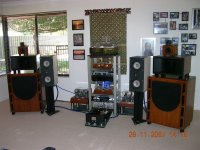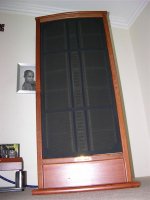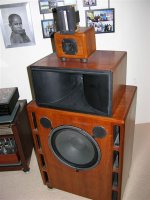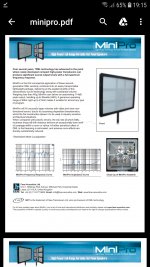This may seem like a rather strange observation that I am making - one that may cause some differences of opinion from both horn and electrostatic camps ...
By way of explanation, I've been a long time user of both the Edgar Horn loudspeaker and a pair of ER Audio ESL-3 fullrange thin membraned (3.4 micron) electrostats + TL subs (see: www.eraudio.com.au ). Settling on these stats after trying many speakers, for the extra speed and resolution that they provide.
The ESL-3 stats have been a long time reference point for me, displaying all the hallmarks of the breed including EXTREME DETAIL RETRIEVAL, the best levels of transparency and a naturalness of tone. All my best efforts at Accutons/Ravens/Seas/Focal/Berylliums/Apogees/Eton/Fostex/Coral/Goodmans Axiom 80 etc, still falling short of the performance of the ESL-3 stats, for overall audiophile performance. Following on from my love of the stats and regardless of the faults I noted in cones-domes & boxes (which I perceived to be slower than stats), I continued to persevere with trying to get the best out of my DIY Edgar Horns, feeling that they had a certain joi-de-vivre (life or liveliness) that could perhaps compete with the low level dynamics of the stats.
To cut a long story short I feel that I have recently finally 'cracked it' with the Edgar Horns, getting the combination of drivers *just right* and by using a DBX active crossover. The Edgars now sound basically as 'holistic, transparent and as real as my electrostats' ...with the added bonus of being able to play all types of music (while not being picky) at any volume level.
My DIY Edgar Horn speaker is a complicated affair running five stereo amplifiers; a DBX Driverack x-o; Eton hexacomb 11-581 for low bass below 40Hz; a 15" RCF 801-P midbass between 40-500Hz; Dynaudio D-54 midrange between 500Hz-6.7kHz; Audax PR120 piezo horn tweeter from 7kH upwards (or a Yamaha JA-4821B compression driver) and a Raven R-1 super tweeter at 16kHz+. All heavily EQ'd for my personal taste in music thru' the DBX's x-o and its parametric equalizer.
The result with the Edgars is now so close to the stats that its hard to pick a preference between the two! A first for me, having always previously preferred the stats over anything else.
So, I'm just wondering whether anyone else out there has noticed a similarity or have a liking for BOTH horns and electrostats, or, am I just imagining that they share similar sonic atttributes when the theory behind their physics and sound is so divergent??
Curious ...
Regards,
Steve M.
All System Pics & Speaker Projects here:
http://forum.audiogon.com/cgi-bin/fr.pl?vevol&1146370182&view
By way of explanation, I've been a long time user of both the Edgar Horn loudspeaker and a pair of ER Audio ESL-3 fullrange thin membraned (3.4 micron) electrostats + TL subs (see: www.eraudio.com.au ). Settling on these stats after trying many speakers, for the extra speed and resolution that they provide.
The ESL-3 stats have been a long time reference point for me, displaying all the hallmarks of the breed including EXTREME DETAIL RETRIEVAL, the best levels of transparency and a naturalness of tone. All my best efforts at Accutons/Ravens/Seas/Focal/Berylliums/Apogees/Eton/Fostex/Coral/Goodmans Axiom 80 etc, still falling short of the performance of the ESL-3 stats, for overall audiophile performance. Following on from my love of the stats and regardless of the faults I noted in cones-domes & boxes (which I perceived to be slower than stats), I continued to persevere with trying to get the best out of my DIY Edgar Horns, feeling that they had a certain joi-de-vivre (life or liveliness) that could perhaps compete with the low level dynamics of the stats.
To cut a long story short I feel that I have recently finally 'cracked it' with the Edgar Horns, getting the combination of drivers *just right* and by using a DBX active crossover. The Edgars now sound basically as 'holistic, transparent and as real as my electrostats' ...with the added bonus of being able to play all types of music (while not being picky) at any volume level.
My DIY Edgar Horn speaker is a complicated affair running five stereo amplifiers; a DBX Driverack x-o; Eton hexacomb 11-581 for low bass below 40Hz; a 15" RCF 801-P midbass between 40-500Hz; Dynaudio D-54 midrange between 500Hz-6.7kHz; Audax PR120 piezo horn tweeter from 7kH upwards (or a Yamaha JA-4821B compression driver) and a Raven R-1 super tweeter at 16kHz+. All heavily EQ'd for my personal taste in music thru' the DBX's x-o and its parametric equalizer.
The result with the Edgars is now so close to the stats that its hard to pick a preference between the two! A first for me, having always previously preferred the stats over anything else.
So, I'm just wondering whether anyone else out there has noticed a similarity or have a liking for BOTH horns and electrostats, or, am I just imagining that they share similar sonic atttributes when the theory behind their physics and sound is so divergent??
Curious ...
Regards,
Steve M.
All System Pics & Speaker Projects here:
http://forum.audiogon.com/cgi-bin/fr.pl?vevol&1146370182&view
Attachments
My first real system was stacked Quad 57's. Lovely in a small room but no dynamic range. Progressed through a lot of gear until full range fromt loaded horns. they had the low distortion, detail and ease of the ESL's at low levels but no dynamic or power compression until extremely high SPL. It's easier to fix the problems with FLH than ESL IMO.
Chalk and cheese. Very different radiation characteristics and polar patterns; the dynamics are entirely different. And to date, every time I've heard a horn system touted to "not sound like horns," I thought, "Sounds pretty good... for a horn."
Yes, I've heard the Edgars. Pretty good... for a horn.
Yes, I've heard the Edgars. Pretty good... for a horn.
Sy: It was also my opinion (until recently) that Horns and Electrostatics sounded completely different. That is, until I got the active crossover and EQ 'just right' on the Edgar Horns. There's virtually zero honk and it sounds very close to the stats for smoothness, coherence, transparency and detail, but with the psychedelic dimensional aspects and strength that horns and boxes seem to give. One regular listener of my various systems said to me... "Steve, you've got those Edgars sounding so nice I think you might have a hard time going back to your stats!". He could be right...
Charles: I don't have any specs on the Audax PR120, I just assumed it was a piezo from the look of it. So what is it, a horn loaded ring radiator perhaps? Whatever it is, it seems to go very nicely with the D-54 Edgar horn mid. I've tried a few high quality tweeters in that position (R-2, Beyma slots & Yamaha compression drivers) and they don't seem to blend as well as the humble PR120 ...Dr Edgar seems to have chosen this driver well to compliment the D-54.
Richard: Thanks for the nice words, but sorry I'm not in Victoria -just 4500km on the other side of Australia in Perth!
Regards,
Steve.
Charles: I don't have any specs on the Audax PR120, I just assumed it was a piezo from the look of it. So what is it, a horn loaded ring radiator perhaps? Whatever it is, it seems to go very nicely with the D-54 Edgar horn mid. I've tried a few high quality tweeters in that position (R-2, Beyma slots & Yamaha compression drivers) and they don't seem to blend as well as the humble PR120 ...Dr Edgar seems to have chosen this driver well to compliment the D-54.
Richard: Thanks for the nice words, but sorry I'm not in Victoria -just 4500km on the other side of Australia in Perth!
Regards,
Steve.
I don't have any specs on the Audax PR120, I just assumed it was a piezo from the look of it. So what is it, a horn loaded ring radiator perhaps?
Yes it is a ring-radiator. They were once quite expensive.
Some vague memories: Usable from 5 kHz, 18 Watts thermal power limit, 109 dB efficient.
Regards
Charles
Not too many bites from you guys to this post, however ...
The only reason I have raised the point that my Edgar Horns are not that much different sounding to my thin membraned electrostats (or for that matter also my Accuton-Raven-Cabasse or Single Driver combinations) is that it seems to me that when you get things 'just right' with any of the various speaker technologies, there seems to be a commonality to the sound produced by any of them.
I would go so far as to say that there is only *one* type of sound produced by any loudspeaker once 'perfection' is attained. That is not to say I have achieved perfection, just a hunch I have after many years of hi-fi'ing and speaker building ...
Regards,
Steve M.
System Pics at:
http://forum.audiogon.com/cgi-bin/fr.pl?vevol&1146370182&view
The only reason I have raised the point that my Edgar Horns are not that much different sounding to my thin membraned electrostats (or for that matter also my Accuton-Raven-Cabasse or Single Driver combinations) is that it seems to me that when you get things 'just right' with any of the various speaker technologies, there seems to be a commonality to the sound produced by any of them.
I would go so far as to say that there is only *one* type of sound produced by any loudspeaker once 'perfection' is attained. That is not to say I have achieved perfection, just a hunch I have after many years of hi-fi'ing and speaker building ...
Regards,
Steve M.
System Pics at:
http://forum.audiogon.com/cgi-bin/fr.pl?vevol&1146370182&view
When I was playing around with some DIY MTMWs and a Pyramid 3-way active crossover about 13 years ago, I had them placed right next to my dad's Quad 63+Gradient subs and could dial them in so close that you couldn't tell them apart initially from the listening position. Good way to adjust them for a particular location in the room. (Now I use headphones to get the balance right.)
But to answer the question: I have never heard horns that didn't sound like horns, and I have found even ratty ESLs (like Final 0.7 and old Acoustats) to have the ESL magic. But I'm biased that way...
But to answer the question: I have never heard horns that didn't sound like horns, and I have found even ratty ESLs (like Final 0.7 and old Acoustats) to have the ESL magic. But I'm biased that way...
Mavo: That's an interesting comment from the notable Siegfried, one that mirrors my own recent experience with two completely different (but now similar sounding) loudspeakers.
Tosh: I suppose there are horns and there are other horns like the Edgar which when you get things just right, it gets the 'horniness' out of the system and starts to sound pretty normal (read: accurate). I used to think that horns and stats were completely different animals - and have a liking for both, for the perceived benefits that each type offers. However, recently I have hit on a combination of drivers and crossover points with my DBX on the Edgar Horns that it now sounds remarkably similar to the elctrostatics I own! Its either that or there are psychoacoustics at play, where I have sub-consciously tuned the Edgar to sound like the stats, the latter being my reference point for good sound in a speaker ??
Regards,
Steve M.
Tosh: I suppose there are horns and there are other horns like the Edgar which when you get things just right, it gets the 'horniness' out of the system and starts to sound pretty normal (read: accurate). I used to think that horns and stats were completely different animals - and have a liking for both, for the perceived benefits that each type offers. However, recently I have hit on a combination of drivers and crossover points with my DBX on the Edgar Horns that it now sounds remarkably similar to the elctrostatics I own! Its either that or there are psychoacoustics at play, where I have sub-consciously tuned the Edgar to sound like the stats, the latter being my reference point for good sound in a speaker ??
Regards,
Steve M.
Steve M said:Sy:
Charles: I don't have any specs on the Audax PR120, I just assumed it was a piezo from the look of it. So what is it, a horn loaded ring radiator perhaps? Whatever it is, it seems to go very nicely with the D-54 Edgar horn mid. I've tried a few high quality tweeters in that position (R-2, Beyma slots & Yamaha compression drivers) and they don't seem to blend as well as the humble PR120 ...Dr Edgar seems to have chosen this driver well to compliment the D-54.
It's a 3/4" titanium diaphragm bullet tweeter. 105dB, 120W power handling! I have a pair which I'm going to put on eBay UK fairly soon, along with a pair of D54AFs.
Stats vs horns...
Just some observations from a guy who had stacked 57's...and then put Kelly ribbons in between them. And then built a 2 x 15 sub. All driven actively from a Teac unit with valves and Amcrons. And that was 1977.
How did it sound, yes, great. But here's the thing. The angle between the stats was critical, the hf beams resulting in the addition of a ribbon tweeter. If you want clout and extension, natural though the bass was the headroom, even stacked, was compromised.
So fussy, (And the panels could resonate physically)..lousy hf dispersion and dynamically limited...but you could live with all the faults because you could swim around in the image. And you needed understanding house mates. Pretty they weren't!
So, in conclusion, no speaker is perfect but if you want dynamics, low distortion and controlled coverage, horns are still relevant.
Small image bland lacklustre doesn't do it for me. Give me loudspeakers that transport you to another place..feel the music and get involved.
And don't disregard modern technology. DSP can control loudspeakers in ways we only uses to dream of back in the day, particularly in the time domain.....?
Just some observations from a guy who had stacked 57's...and then put Kelly ribbons in between them. And then built a 2 x 15 sub. All driven actively from a Teac unit with valves and Amcrons. And that was 1977.
How did it sound, yes, great. But here's the thing. The angle between the stats was critical, the hf beams resulting in the addition of a ribbon tweeter. If you want clout and extension, natural though the bass was the headroom, even stacked, was compromised.
So fussy, (And the panels could resonate physically)..lousy hf dispersion and dynamically limited...but you could live with all the faults because you could swim around in the image. And you needed understanding house mates. Pretty they weren't!
So, in conclusion, no speaker is perfect but if you want dynamics, low distortion and controlled coverage, horns are still relevant.
Small image bland lacklustre doesn't do it for me. Give me loudspeakers that transport you to another place..feel the music and get involved.
And don't disregard modern technology. DSP can control loudspeakers in ways we only uses to dream of back in the day, particularly in the time domain.....?
so what other technology yields the realistic dynamics of horn loading? You can horn load any of the following. The top technologies which are the most dynamic are horns electrostats and ribbons these are also the lowest in distortion (plasma belongs in there due to low distortion but it lacks efficiency).
Horns are hard to beat for efficiency of course and require very little power from the amp. This potentially results in low distortion ..?
You mention the plasma tweeter. Yes, truly massless. A mate had one (Magnat). Great if you could live with the ozone!! And you still have to match it to other units.
So I am guessing the holy grail is still a full range device with even power distribution over the audible spectrum..and preferably omnidirectional.
I'm going to stick my neck out here and probably be hammered for it but sometime back I bought 4 of the Fane mp80 dml panels. I won't go into the "technology" but there are plenty of papers out there to read. Before the hail of abuse (!) Let's look at what they were/are capable of. Power handling, a good 80 watts from around 80Hz. Stacked, response down to around 50Hz. 91dB for a watt in this configuration. They are not pistonic but "resonant" resulting in superb impulse response times and very low distortion. "Properly" full range compared to all other supposed FR "drivers".
Unlike any other conventional speaker, they sum evenly when you stack them and hf dispersion improves the more you have. They are very low in "colouration", and due to their mode of operation and even power response, tend to excite room resonances less than their directional beamy conventional counterparts.
A criticism is that they don't sound like a conventional speaker!! One manufacturer (Techtonik?) manufactures them for stage use and deploys a ribbon for the hf. I can only assume they believe directional hf has benefits.
I wish more research and funding had gone into this NXT technology for audio use before market forces denied it the place it deserved. All other transducer technology available to us have been developed over decades ..its a shame this new technology hasn't had the same attention? A single efficient virtually full range driver with even power delivery across virtually the whole audible spectrum and no crossovers? What's not to like!!
You mention the plasma tweeter. Yes, truly massless. A mate had one (Magnat). Great if you could live with the ozone!! And you still have to match it to other units.
So I am guessing the holy grail is still a full range device with even power distribution over the audible spectrum..and preferably omnidirectional.
I'm going to stick my neck out here and probably be hammered for it but sometime back I bought 4 of the Fane mp80 dml panels. I won't go into the "technology" but there are plenty of papers out there to read. Before the hail of abuse (!) Let's look at what they were/are capable of. Power handling, a good 80 watts from around 80Hz. Stacked, response down to around 50Hz. 91dB for a watt in this configuration. They are not pistonic but "resonant" resulting in superb impulse response times and very low distortion. "Properly" full range compared to all other supposed FR "drivers".
Unlike any other conventional speaker, they sum evenly when you stack them and hf dispersion improves the more you have. They are very low in "colouration", and due to their mode of operation and even power response, tend to excite room resonances less than their directional beamy conventional counterparts.
A criticism is that they don't sound like a conventional speaker!! One manufacturer (Techtonik?) manufactures them for stage use and deploys a ribbon for the hf. I can only assume they believe directional hf has benefits.
I wish more research and funding had gone into this NXT technology for audio use before market forces denied it the place it deserved. All other transducer technology available to us have been developed over decades ..its a shame this new technology hasn't had the same attention? A single efficient virtually full range driver with even power delivery across virtually the whole audible spectrum and no crossovers? What's not to like!!
DML
Here's a pic of the Fane product sheet. Frequency response is not everything without even power response? I managed to flatten the response out quite well in dsp with IIR filters. Is this a situation where FIR filters could be beneficial? Comments on that anyone?
Here's a pic of the Fane product sheet. Frequency response is not everything without even power response? I managed to flatten the response out quite well in dsp with IIR filters. Is this a situation where FIR filters could be beneficial? Comments on that anyone?
Attachments
@SoundRight Never done FIR correction on a distributed mode speaker, but generally they have a very messy polar response (which you tend not to notice by listening) this means that you have to come up with some way to get a meaningful average response and correct that. It will probably never really sound accurate.
- Status
- This old topic is closed. If you want to reopen this topic, contact a moderator using the "Report Post" button.
- Home
- Loudspeakers
- Multi-Way
- "Are Horns Really that Much Different from Electrostatics ..."



